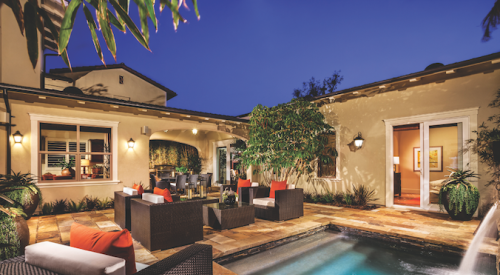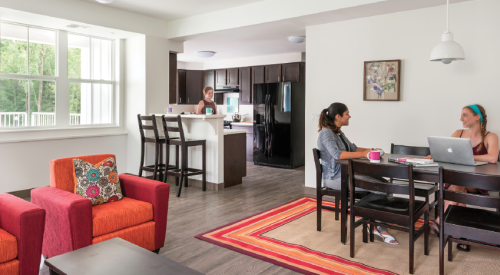Click here to read more about designing outdoor spaces.
1. Prioritize privacy. When density is in play, private spaces back up onto other houses, and often they’re more public than desired. No one wants the neighbors looking on when they’re having a quiet dinner with friends. The outdoor space needs to offer a sense of safety, privacy, and refuge. A fireplace is one great way to block off the neighbors’ view, and it means that the space can be used beyond warm weather. Forecourts are another way to prioritize privacy.
2. Nail the scale. Like any other room in the house, an outdoor room has to beckon you to step outside and come use it. The space can’t be so small—or large—that buyers wonder what to do with it. If you have an outdoor space surrounded by two-story edges, you’re shutting down the light capability that comes into the house via that outdoor space. Relieve that tall scale with a single-story roof edge or partially enclose the space.
3. Connect interior and exterior. The outdoor space has to be an extension of the indoor activity; otherwise, it won’t see regular use. The object is to bring the indoors out and the outdoors in with ease of livability. Outdoor dining needs to connect with the kitchen. An outdoor garden needs to link to a private hot tub or outdoor shower, if there is one, which needs to connect to the master bath. Consider which rooms open out to that space, and are they rooms that are public space or private? Setting outdoor space off the main hallway doesn’t make a lot of sense if that hallway leads to the master bedroom.
4. Be cost-conscious. Maximize natural light with cost-efficient windows and doors. Not everyone will be able to afford an $800-a-foot sliding door. Can that price come down so it’s $400 or $500 a foot, depending on the market? Blandford Homes, in Phoenix, used a smart tactic. It offered simple 8-foot glass sliders in alley-loaded single-family detached homes as an option—at cost. The builder’s homes became one of the top sellers in the market, with more than 80 percent of buyers opting to include the sliders.
5. Head upstairs. An outdoor space on the first floor carries the most value, but it’s appealing to buyers on the second floor, too. The ones I’ve seen are more than balcony decks, they’re an extension of the room, beginning at about 100 square feet, and they don’t require a lot of maintenance.
Read more from Nick Lehnert about leveraging outdoor spaces
---
Nick Lehnert, who has more than 40 years of experience in home building, heads KTGY Architecture + Planning’s Market Research and R + D Design, in Irvine, Calif. Reach him at nlehnert@ktgy.com.












